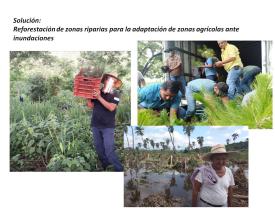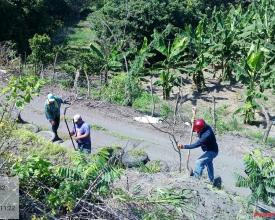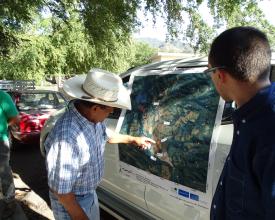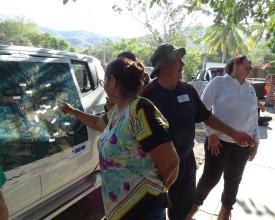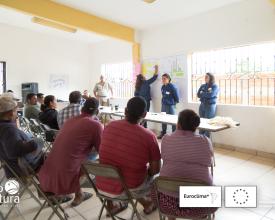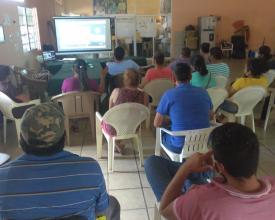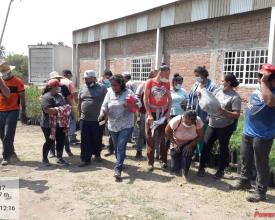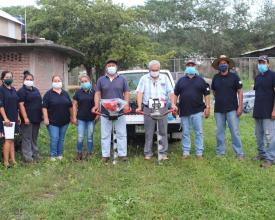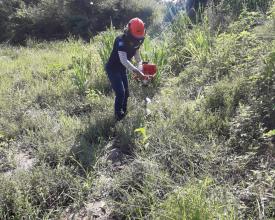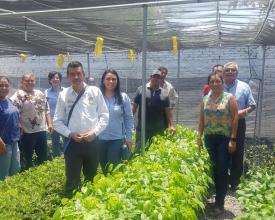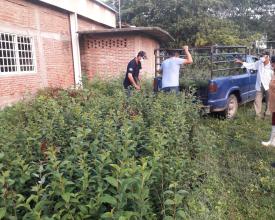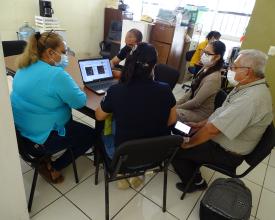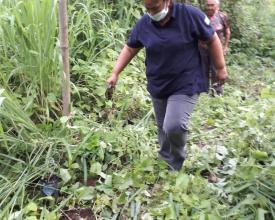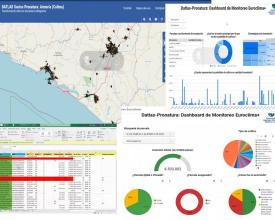
Reforestation of riparian zones for adaptation of agricultural areas to floods
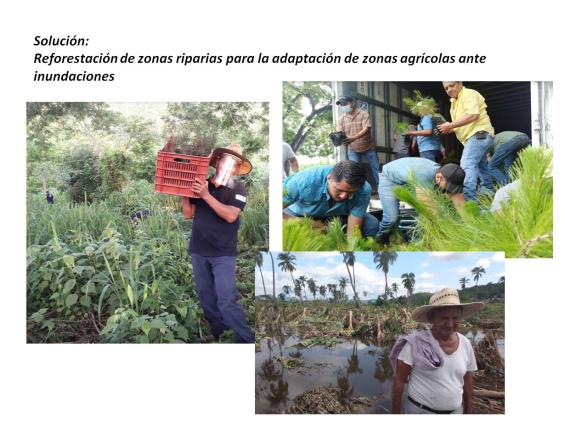
Armería Colima, Mexico is a municipality highly vulnerable to climate change due to the fact that:
- climatic events such as storms and hurricanes, which are increasingly frequent and intense, have great destructive power in the municipal territory.
- the forms of use and occupation of riparian zones have contributed to the loss of environmental services that these zones provide, increasing the municipality's vulnerability to flooding.
- the damage to infrastructure and roads makes communication and support to localities affected by floods difficult.
- there are high levels of social backwardness,
- ecological restoration, conservation schemes and mechanisms for payment for environmental services are existing instruments in the state, but they have not been established as aids to municipal adaptation to climate change.
Context
Challenges addressed
Environmental challenges:
- Recover eroded soils, riparian biodiversity and ecosystem services.
Social challenges.
- lack of community early warning systems
- conflicting uses of the riparian zone
- irregular settlements.
Public involvement and governance
- Land use regulation,
- New alliances and support networks
Location
Process
Summary of the process
The 5 Building Blocks (BB) presented in this solution refer to those axes that facilitate the articulation of global and national agendas from the local level, within the framework of a Municipal Climate Change Adaptation Program, a municipal planning instrument that promotes the inclusion of adaptation measures based on ecosystems, with a focus on sustainable livelihoods.
Building Blocks
Institutional strengthening and governance of natural assets
The purpose of this block was to build an enabling environment for political advocacy in favor of the adaptation of municipal natural and social systems that are vulnerable to current and future climate impacts. To achieve this, two components were worked on:
Enabling conditions
- Workshops to integrate biodiversity values into climate change adaptation strategies and municipal development planning processes and to reduce socioeconomic and environmental conditions that exacerbate climate impacts.
- Establishment of agreements and synergies between ejido, municipal, state and federal authorities, as well as education and research centers to support the integration of ecosystem-based adaptation into municipal development planning and improve governance of natural assets.
Coordination mechanisms
Consolidation of horizontal and vertical networks through consultation and working groups that facilitated the development of the adaptation process:
- The Expert Working Group.
- The Municipal Adaptation Council
- The Community Working Group
- The Peasant Learning Communities
Enabling factors
This component is fundamental because it provides legal, technical and programmatic support to the solution, which allows it to be incorporated into municipal planning, to address an area that has not been worked on in the Municipality of Armería: the development of climate action plans, which has allowed the municipal authorities to resume their responsibilities in the area of climate change.
Lesson learned
Building an enabling environment for the implementation of climate change adaptation measures requires several components:
- using scientific knowledge to conduct vulnerability analyses of agriculture to flooding, direct pressures on riparian ecosystems, and providing advice for the development of environmental, social and gender safeguards
- targeting municipal development goals that may be affected by flooding, integrating adaptation objectives and criteria into municipal planning and budgeting to provide necessary inputs for implementation of the solution
- Consider ejido and community leaders as key actors in the mediation between municipal authorities and farmers' collectives that contribute to the implementation of the solution.
- Including the citizen monitoring component allows for the sustainability of the measure and the empathetic and proactive involvement of the communities involved.
Capacity building for the mobilization and empowerment of vulnerable groups
The purpose of this block is to generate tools to understand and evaluate the impacts and opportunities that biodiversity and ecosystem-based adaptation to climate change offer in the face of climate change conditions. To this end, three types of training processes were developed:
Valuation of ecosystem services
- Awareness-raising actions on the role of riparian ecosystem services in reducing the vulnerability of livelihoods to floods.
Increased climate resilience of livelihoods,
- Workshops for the elaboration of impact chains (community analysis of the vulnerability of their livelihoods).
- Workshops to define and prioritize actions for adaptation to climate change.
- Working meetings for the analysis and development of the implementation strategy.
Actions in the territory
- Training and formation of the AbE Squadron (group of women and men in charge of seed collection, location of sites to be reforested and planning of activities for this purpose).
Enabling factors
- The livelihoods approach made it possible to recognize social, economic and cultural aspects that affect vulnerability to climate change.
- The community valuation of ecosystem services made it possible to identify their relevance in reducing the vulnerability of livelihoods, making the measure sustainable.
- The participation of Municipal and Ejido Committees strengthened horizontal and vertical work and collaboration networks.
Lesson learned
The recovery of local knowledge, practices and innovations oriented to the management of agricultural-riparian zones in the face of floods (obtained from surveys and analysis of community perceptions) is a fundamental basis for the design, implementation and monitoring of the proposed solution.
A nature-based solution does not neglect the main and most felt problems of the population and municipal livelihoods, with a participatory and gender approach.
The design and implementation process has also been highly participatory. Opportunities for participation have been created for men and women of the Ejido through a capacity building process that integrates community experience, technological know-how and new perspectives on the territory.
Ecosystem-based adaptation (EbA) with a sustainable livelihoods approach
The block shows the actions taken to establish the relationship between livelihoods and ecosystems, with emphasis on the benefits they provide: services and functions that are the most important part of the natural capital of our communities.
Capacity building on Ecosystem-based Adaptation (EbA)
- The EbA approach oriented the analysis of livelihood vulnerability, the choice of measures of biodiversity use and ecosystem services, showing how they help people and their livelihoods to adapt to the adverse effects of climate change and indicators for monitoring the solution.
Actions in the territory
- Establishment of 2 community nurseries with a production of 9,226 native plants with which 67.5 ha. of riparian zones were reforested.
- Participation in the benefits derived from the restoration of riparian zones.
- Community reforestation in riparian zones contributing to the health, livelihoods and well-being of local communities, taking into account the needs of women and the poor and vulnerable.
Enabling factors
Reinforced learning that the vulnerability of livelihoods and the fragility and degradation of local ecosystems and the services and functions they provide are strongly correlated, facilitated understanding of the importance of halting the loss of biodiversity and significantly reducing its degradation and fragmentation and ensuring that these ecosystems continue to provide essential services to contribute to the well-being of the municipality's farming communities.
Lesson learned
- Keep in mind that we work with social-ecological systems, that is, with people and livelihoods linked to goods and services that are necessary to sustain life.
- Valuing ecosystem services as a tool for adaptation helps to recognize the contribution ecosystems make to human well-being and to understand how they contribute to reducing the consequences of climate change impacts.
- Although the EbA solution favors communities, it is necessary to establish it as part of a broader adaptation strategy that takes into account that there are social, economic and institutional conditions that exert pressure on municipal social-ecological systems and must therefore be modified to have a real impact on reducing vulnerability.
Resources
Citizen monitoring
The SbN citizen monitoring exercise is a useful tool in the analysis of better solution alternatives for local communities, but also to promote good governance and transparency, since it allows citizens to learn about the problems and challenges of ecosystem-based adaptation actions and to propose complementary alternatives for improving social organization, diversifying economic activities, new governance practices, among others:
- to know the problems and challenges of ecosystem-based adaptation actions and the proposal of complementary alternatives for the improvement of social organization, diversification of economic activities, new governance practices, among others.
- Raise realistic expectations about collective action and better understand their role as contributors to local well-being.
- Recognize the relationship between adaptation to climate change and local development that responds to the needs, demands and realities of vulnerable groups.
Enabling factors
-The Peasant Learning Communities are groups of farmers organized by agricultural sectors, whose leaders are responsible for coordinating the collection of information on the implementation of the measure and monitoring its results.
Lesson learned
Citizen monitoring of the solution should be oriented towards recognizing :
- Changes in the institutional framework of the adaptation process.
- Changes in the vulnerability conditions of agricultural livelihoods (biophysical, social and economic).
- Changes in the resilience conditions of livelihoods (recovery in less time, reduction of losses and damages, better knowledge of the factors that exacerbate the impacts of floods, systematization of experience, innovation and adaptive management).
To obtain favorable results, farmer leaders should be trained to:
- obtain quality local information
- Carefully select data according to each monitoring component.
- thoroughly validate the information with the support of field technicians
- structure the information based on the Datlas Platform
Knowledge Management and Climate Change Adaptation
This block refers to the set of activities and processes that strengthen the exchange of information and experiences related to the design, implementation and monitoring of the solution. This allows building a shared knowledge base with the potential to facilitate the adaptation process and accelerate innovation and expected change/adjustments.
The main activities are:
- Formation and training of commissions to recover local narratives that interweave actors, perceptions, experiences, knowledge and changes that are triggered throughout the adaptation process,
- Systematization of the solution to identify lessons learned and confirm the results of the process.
- Elaboration and dissemination of materials with great communicative power that show the territory, the actions carried out and the main protagonists of the adaptation process.
Enabling factors
- Understanding that beneficiaries are the key actors in climate change adaptation processes.
- Identifying and listening to community narratives makes it possible to recognize the resilience of their livelihoods.
- Vulnerability to floods is differentiated for women and men, as well as the strategies and capacities they bring into play to face it.
- Communication materials should consider the needs and capacities of different groups and enhance their participation and empowerment.
Lesson learned
- Adaptation to climate change is also a process of innovation, and as such is a path and not a destination. Its raison d'être is to make visible the conditions that increase the vulnerability of a system of interest and to offer solutions that generate a positive impact on the quality of life of people and the ecosystems that sustain them.
- For this reason, knowledge management plays an important role, as it allows generating a virtuous cycle of learning and improvement of adaptive management and disaster risk reduction processes; hence the importance of promoting a permanent reflection on reality and a more dynamic and lively flow of knowledge between beneficiaries, technical teams and the general project, which allows creating more robust solutions.
Impacts
In order to reduce climate impacts on the population and livelihoods, a nature-based solution (NBS) is proposed that seeks to contribute to the adaptation of agricultural communities settled in riparian areas, based on a participatory and inclusive process that will enable the formulation of policies and actions for local adaptation to floods.
Beneficiaries
Agricultural producers affected by floods
- 200 families, 25% of which are female-headed households, all of them involved in agricultural activities.
- 9 localities and 13 small towns in the municipality of Armería.
Sustainable Development Goals
Story
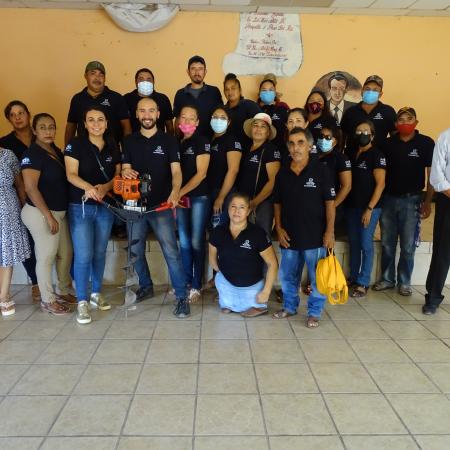
Reforestadoras de vida.
Considering inequality gaps in access to means of production, financing, training and decision-making are challenges that must be taken into account when working on climate change adaptation projects. The solution included them by including as beneficiaries female heads of household linked to agricultural activities, whose fields are vulnerable to flooding.
These women, who would make up the AbE Squadron, called themselves "Reforestadoras de vida" (Reforesters of Life), recognizing that riparian reforestation helps to protect water sources, conserve the functionality of riparian ecosystems and reduce the impacts of climate change. That their participation and knowledge in the installation of community nurseries and the production of native plants would not only favor the connectivity of lowland rainforest, but would also reduce the total losses caused by floods and provide them with an alternative livelihood to improve their economic conditions.
Women in the field, organized, leading work teams, developing new skills to handle tools (power tillers, planting drills) and technological equipment (GPS, videos, projectors); identifying forest species and collecting seeds for classification and treatment. Women who work to protect ecosystems, because they know their importance in local sustainability, in the security of their homes and livelihoods.
This great effort was recognized by the communities and by the ejido and municipal authorities. Their fellow producers proudly point out that the women of Armerita do a magnificent job for the land where they were born, because they are full women, full of hope and faith and with a high sense of solidarity that is an example for all.
Including the gender approach in this solution has created and induced a new space of relationships and facts that have repercussions on the worldview of men and women, which values the knowledge and needs of women, reconceptualizes the ways of working, social and sexual roles, organizational culture and cultural spheres. Fundamental elements for better governance and quality of life in the territory.
